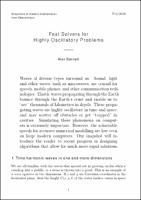| dc.contributor.author | Barnett, Alex | |
| dc.contributor.editor | Bruschi, David Edward | |
| dc.contributor.editor | Niediek, Johannes | |
| dc.contributor.editor | Cederbaum, Carla | |
| dc.date.accessioned | 2018-06-26T13:16:00Z | |
| dc.date.available | 2018-06-26T13:16:00Z | |
| dc.date.issued | 2018-06-26 | |
| dc.identifier.uri | http://publications.mfo.de/handle/mfo/1370 | |
| dc.description.abstract | Waves of diverse types surround us. Sound, light
and other waves, such as microwaves, are crucial for
speech, mobile phones, and other communication technologies.
Elastic waves propagating through the Earth
bounce through the Earth’s crust and enable us to
“see” thousands of kilometres in depth. These propagating
waves are highly oscillatory in time and space,
and may scatter off obstacles or get “trapped” in
cavities. Simulating these phenomena on computers
is extremely important. However, the achievable
speeds for accurate numerical modelling are low even
on large modern computers. Our snapshot will introduce
the reader to recent progress in designing
algorithms that allow for much more rapid solutions. | en_US |
| dc.language.iso | en | en_US |
| dc.publisher | Mathematisches Forschungsinstitut Oberwolfach | en_US |
| dc.relation.ispartofseries | Snapshots of modern mathematics from Oberwolfach;2018,06 | |
| dc.rights | Attribution-ShareAlike 4.0 International | * |
| dc.rights.uri | http://creativecommons.org/licenses/by-sa/4.0/ | * |
| dc.title | Fast Solvers for Highly Oscillatory Problems | en_US |
| dc.type | Article | en_US |
| dc.identifier.doi | 10.14760/SNAP-2018-006-EN | |
| local.series.id | SNAP-2018-006-EN | en_US |
| local.subject.snapshot | Numerics and Scientific Computing | en_US |
| dc.identifier.urn | urn:nbn:de:101:1-2018062712223777857766 | |
| dc.identifier.ppn | 1653385774 | |


